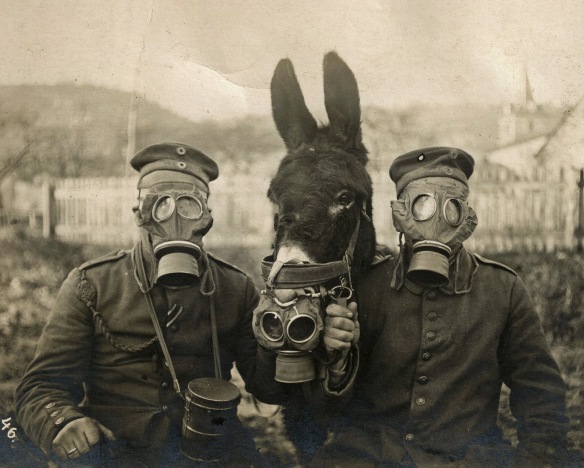World War 1, also known as the First World War or the Great War and the War to End All Wars, was a world conflict lasting from 1914 to 1919, with the fighting lasting until 1918. The war was fought by the Allies on one side, and the Central Powers on the other. No previous conflict had mobilized so many soldiers or involved so many in the field of battle. By its end, the war had become the second bloodiest conflict in recorded history.

148th American Aero Squadron field. Making preparations for a daylight raid on German trenches and cities. The machines are lined up and the pilots and mechanics test their planes. Petite Sythe, France. (August 6, 1918)
World War 1 became infamous for trench warfare, where troops were confined to trenches because of tight defenses. This was especially true of the Western Front. More than 10 million died on the battlefield, and nearly that many more on the home fronts because of food shortages, genocide, and ground combat. Among other notable events, the first large-scale bombing from the air was undertaken and some of the century’s first large-scale civilian massacres took place, as one of the aspects of modern efficient, non-chivalrous warfare.
The Start of World War I
The spark that started World War I was the assassination of Austria’s Archduke Franz Ferdinandand his wife Sophie. The assassination occurred on June 28, 1914 while Ferdinand was visiting the city of Sarajevo in the Austro-Hungarian province of Bosnia-Herzegovina.
Although Archduke Franz Ferdinand, the nephew of Austria’s emperor and heir-apparent to the throne, was not very well liked by most, his assassination by a Serb nationalist was viewed as a great excuse to attack Austria-Hungary’s troublesome neighbor, Serbia.
However, instead of reacting quickly to the incident, Austria-Hungary made sure they had the backing of Germany, with whom they had a treaty, before they proceeded. This gave Serbia time to get the backing of Russia, with whom they had a treaty.
The calls for back-up didn’t end there. Russia also had a treaty with France and Britain.
This meant that by the time Austria-Hungary officially declared war on Serbia on July 28, 1914, an entire month after the assassination, much of Europe had already become entangled in the dispute.
At the start of the war, these were the major players (more countries joined the war later):
- Allied Forces (a.k.a. the Allies): France, the United Kingdom, Russia
- Central Powers: Germany and Austria-Hungary

Verdun 1916
The Battle of Verdun was fought from 21 February – 18 December 1916 during the First World War on the Western Front between the German and French armies, on hills north of Verdun-sur-Meuse in north-eastern France. The German Fifth Army attacked the defences of the Région Fortifiée de Verdun (RFV) and the Second Army on the right bank of the Meuse, intending to rapidly capture the Côtes de Meuse (Meuse Heights) from which Verdun could be overlooked and bombarded with observed artillery-fire.
Schlieffen Plan vs. Plan XVII
Germany didn’t want to fight both Russia in the east and France in the west, so they enacted their long-standing Schlieffen Plan. The Schlieffen Plan was created by Alfred Graf von Schlieffen, who was the chief of the German general staff from 1891 to 1905.
Schlieffen believed that it would take about six weeks for Russia to mobilize their troops and supplies. So, if Germany placed a nominal number of soldiers in the east, the majority of Germany’s soldiers and supplies could be used for a quick attack in the west.
Since Germany was facing this exact scenario of a two-front war at the beginning of World War I, Germany decided to enact the Schlieffen Plan. While Russia continued to mobilize, Germany decided to attack France by going through neutral Belgium. Since Britain had a treaty with Belgium, the attack on Belgium officially brought Britain into the war.
While Germany was enacting its Schlieffen Plan, the French enacted their own prepared plan, called Plan XVII. This plan was created in 1913 and called for quick mobilization in response to a German attack through Belgium.

Photograph of two unidentified World War I soldiers. Courtesy of Mrs. J.H. Alexander and Mrs. E.R. Dean. World War Roll of Honor, 1917-1920, Marion County Kansas.
As German troops moved south into France, French and British troops tried to stop them. At the end of the First Battle of the Marne, fought just north of Paris in September 1914, a stalemate was reached. The Germans, who had lost the battle, had made a hasty retreat and then dug in. The French, who couldn’t dislodge the Germans, then also dug in. Since neither side could force the other to move, each side’s trenches became increasingly elaborate. For the next four years, the troops would fight from these trenches.
A War of Attrition
From 1914 to 1917, soldiers on each side of the line fought from their trenches. They fired artillery onto the enemy’s position and lobbed grenades. However, each time military leaders ordered a full-fledged attack, the soldiers were forced to leave the “safety” of their trenches.
The only way to overtake the other side’s trench was for the soldiers to cross “No Man’s Land,” the area between the trenches, on foot. Out in the open, thousands of soldiers raced across this barren land in the hopes of reaching the other side. Often, most were hewn down by machine-gun fire and artillery before they even got close.
Because of the nature of trench warfare, millions of young men were slaughtered in the battles of World War I. The war quickly became one of attrition, which meant that with so many soldiers being killed daily, eventually the side with the most men would win the war.
By 1917, the Allies were starting to run low on young men.
U.S. Enters the War and Russia Gets Out
The Allies needed help and they were hoping that the United States, with its vast resources of men and materials, would join on their side. However, for years, the U.S. had clung to their idea of isolationism. Plus, the U.S. just didn’t want to be involved in a war that seemed so far away and that didn’t seem to affect them in any great way.
However, there were two major events that changed American public opinion about the war. The first occurred in 1915, when a German U-boat (submarine) sunk the British ocean liner RMS Lusitania. Considered by Americans to be a neutral ship that carried mostly passengers, Americans were furious when the Germans sank it, especially since 159 of the passengers were Americans.

Photostat of the Zimmermann Telegram as received by the German ambassador to Mexico (Jan. 19, 1917) In the midst of World War I, German Foreign Minister Arthur Zimmermann sent an encoded message to the President of Mexico proposing a military alliance against the United States. In return for Mexican support in the war, Germany would help Mexico regain New Mexico, Texas, and Arizona from the United States. The British intercepted the secret message, deciphered it, and turned it over to the U.S. Government. (Picture from the National Archives and Records Administration.)
The second was the Zimmermann Telegram. In early 1917, Germany sent Mexico a coded message promising portions of U.S. land in return for Mexico joining World War I against the United States. The message was intercepted by Britain, translated, and shown to the United States. This brought the war to U.S. soil, giving the U.S. a real reason to enter the war on the side of the Allies.
On April 6, 1917, the United States officially declared war on Germany.
As the United States was entering World War I, Russia was getting ready to get out.
In 1917, Russia became swept up in an internal revolution that removed the czar from power. The new communist government, wanting to focus on internal troubles, sought a way to remove Russia from World War I. Negotiating separately from the rest of the Allies, Russia signed the Brest-Litovsk peace treaty with Germany on March 3, 1918.
With the war in the east ended, Germany was able to divert those troops to the west in order to face the new American soldiers.
Armistice and the Versailles Treaty

A newspaper headlining the end of World War 1. The Treaty of Versailles was signed at 2 p.m. on June 28, 1919.
The fighting in the west continued for another year. Millions more soldiers died, while little land was gained. However, the freshness of the American troops made a huge difference. While the European troops were tired from years of war, the Americans remained enthusiastic. Soon the Germans were retreating and the Allies were advancing. The end of the war was near.

Sergeant Alvin York, a backwoods Tennessean who became the most highly decorated soldier of World War I.
At the end of 1918, an armistice was finally agreed upon. The fighting was to end on the 11th hour of 11th day of 11th month (i.e. 11 am on Nov. 11, 1918).
For the next several months, diplomats argued and compromised together in order to come up with the Versailles Treaty. The Versailles Treaty was the peace treaty that ended World War I; however, a number of its terms were so controversial that it also set the stage for World War II.
The carnage left behind by the end of World War I was staggering. By the end of the war, an estimated 10 million soldiers were killed. That averages to about 6,500 deaths a day, every day. Plus, millions of civilians were also killed. World War I is especially remembered for its slaughter for it was one of the bloodiest wars in history.
On the Web:
World War I – Battles, Facts, Videos & Pictures
A Multimedia History of World War One
Sgt. Alvin York (Sergeant York)
Crash



